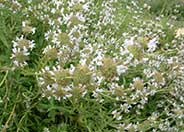
Common name:Woolly Blue Curls
Botanical name:Trichostema lanatum
The Woolly Blue Curls is an evergreen shrub that reaches 3'-5' high. It has an open branching habit and has long stalks of brilliant purple woolly flowers in the spring and summer. This shrub is native to California, is drought tolerant, and attracts hummingbirds. -Cornflower Farms

Common name:Black Sage
Botanical name:Salvia mellifera
This woody shrub has fragrant, dark green leaves with blue, white, or lilac flowers that bloom in the spring and summer.

Common name:Ray Hartman California Lilac
Botanical name:Ceanothus 'Ray Hartman'
Growing vigorously as either a large shrub or small tree, the Ray Hartman has big leaves and medium blue, delicate flowers in 3"-5" clusters. It grows to 12' high and 8'-10' wide. This cultivar has good tolerance for heat; it needs occasional deep waterings with good drainage. It attracts hummingbirds, butterflies and beneficial insects. - Cornflower Farms

Common name:California Fuchsia, Zauschneria
Botanical name:Epilobium canum canum
The California fuchsia is a perennial with dense, narrow, green gray foliage and red orange summer flowers. The growth habit of this plant is sprawling and low. The California fuchsia is native to California, is drought tolerant, and attracts hummingbirds. -Cornflower Farms
Compost for Healthy Soil and Plants
The natural world works in cycles. Everything is changing form and moving from place to place in an endless energy exchange system. The leaves and twigs that fall to the ground, not to mention other life forms that might die, decompose and combine with water, air and minerals of the soil to create a medium for future plants.
Click in the green box for more information
| Designer: Bob Perry and Asso. | Claremont Skies |
Photographer: GardenSoft |
Soils and Compost:
Maintain a two to four inch layer of mulch on the soil surface to reduce weeds, infiltrate rain water, and reduce compaction.
Water Saving Tip:
Integrated Pest Management:
Drip and other smart irrigation delivers water directly to roots, allowing no excess water for weeds.

